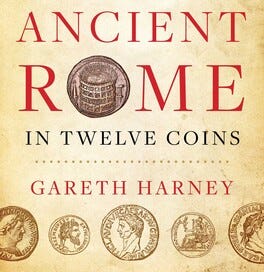Book Review: A History of Ancient Rome in Twelve Coins by Gareth Harney
Back in early 2020, I had received a grant to present at a major classical conference as part of a wider project we called “Leadership Through ‘Obversity,’” which consisted of a similar argument to this book, in that history education can be improved by the inclusion of the physical remnants of their monetary system. Unfortunately, because of other things that happened in early 2020, the trip got cancelled and the project got shelved.
Our intent at that time was to research enough artifacts to publish a slim volume suitable for use in the classroom. Gareth Harney has taken a different approach to tackling the same gap in understanding: he selected what he views as the twelve most critically important or significant examples in the field and wrote about why he feels that way for a more popular audience.
The first half of every chapter fabulizes the relevant story on the chosen coin. The prose here is light and imaginative, which at times makes the project feel more like a storybook than a rigid exploration of history. That being said, Harney does do his due diligence in citing the sources that detail the historical events being covered in the chapter. In describing the extant descriptions of the Colosseum, for example, Harney not only mentions the Venerable Bede’s poem about the amphitheater but additionally lists Lord Byron, Canaletto, Piranesi, and Turner as others who have written about or painted it.
The second half, then, draws from more modern sources like archeological digs to judge the verity of the ancient stories. I don’t typically approve of the way that some archeologists hold modern scientific attitudes to be wholly superior to literary sources, because quite often even deeper research will prove those attitudes wrong. Here, the bias comes from the way Harney has chosen to structure his book rather than any expressed feelings of his, which is fine, but it may limit the imagination of the reader to what our current understanding of history is and not broaden it to what is possible if read the wrong way.
The other way that this book skews towards archeology is through the selection of the topics that Harney discusses. One would expect that all the coins in question depict well-known figures on the obverse, but it is often the features on the reverse that are the main focus of the stories at hand. The chapter covering the founding of Rome uses the image of the she-wolf nursing the famous twins of Rhea Silvia, which draws to mind a comparison to the iconic Capitoline Wolf bronze. There is little issue for this solitary event because it has the greatest connection back to that reign, which was older than the invention of monetary systems. When emperors begin to intentionally issue coinage, there are propagandistic reasons that they pick images to associate themselves with. For example, there are a handful of denominations which depict crocodiles in order to associate rulers with economic or cultural successes in Egypt. While these may not be as important to the historical record as, say, the building of the Colosseum, this story tells a different perspective than one tends to get in the average history-book anyway.
It sounds ridiculous to criticize a book about ancient Roman coins to focus on coins from Ancient Rome, but I would have liked to see more examples from the provinces rather than just Roman denominations. There was a lot more happening outside of the “eternal city” than people realize, especially after Diocletian, and it would have been nice to see it represented somewhere. We’ve been over the whole “Byzantium” debate recently so I won’t rehash the issue, but the fact of the matter is that the people living there and their emperor both called themselves Roman for many years after the empire in the West fell as well.
I was a little shocked at one particular disinclusion; Harney professes a love for Trajan (one that I share with him), and a provincial coin celebrating the Parthian campaigns that brought Rome to its greatest size would have been more apt in my opinion than the one of his column. A single drachma or shekel among the denarii would have made the book feel like a more complete assessment of the world. On the other hand, if this “absence” leads to future entries in a series covering other parts of the ancient Mediterranean, I’ll happily pick up a few more copies.
Gareth Harney has done a great service to the numismatic community in connecting the dots between their field and teachable history. There has been a grey area between the two for years, and the popular perception of the discipline as a mere hobby rather than a valuable aspect of archeology has done a great disservice to students. It’s hard to think of an area where one can receive rigorously detailed lists of artifacts at a moment’s notice more easily than on one of their websites. That being said, this book does not seem to wish to add much to the overall discussion of history, but instead walks over well-trod soil. This would be fantastic as a book for people just beginning to dip their toes into the study of history, especially young ones. Consider picking this up for the budding student in your life. 2 stars.





